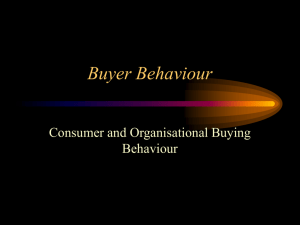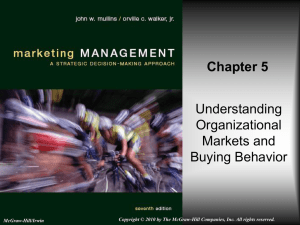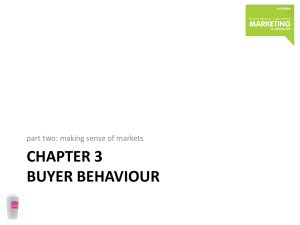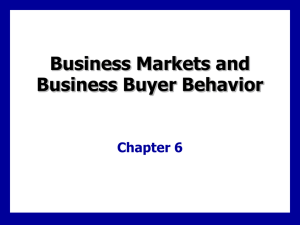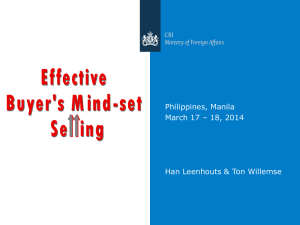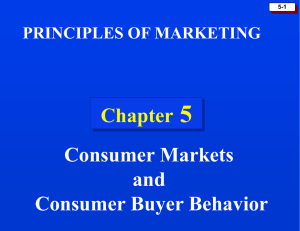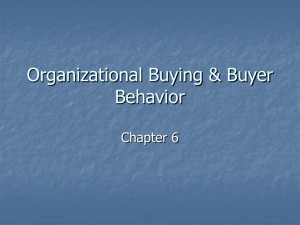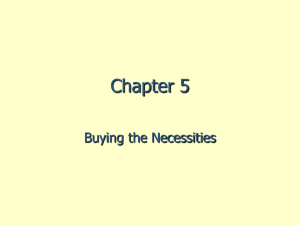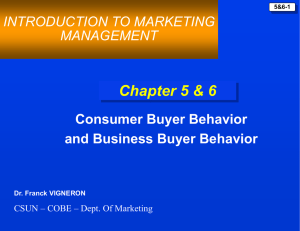Chapter – 3 Consumer and Organizational Buyer Behavior
advertisement
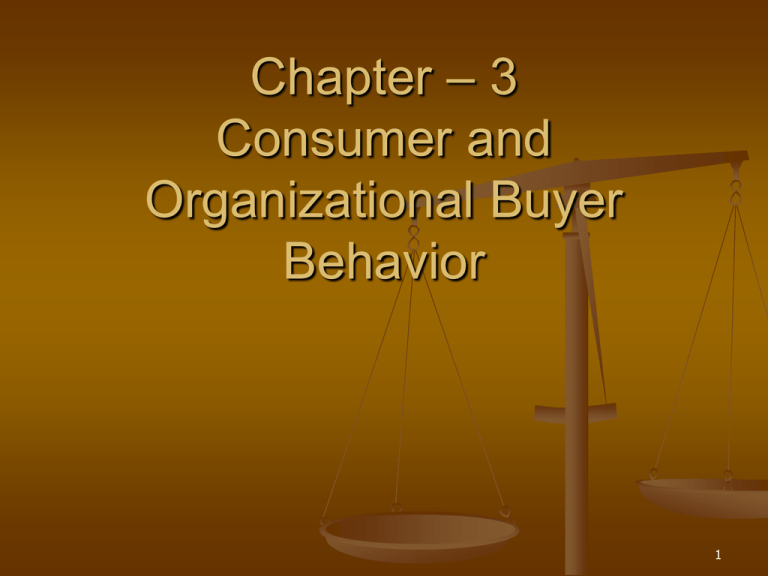
Chapter – 3 Consumer and Organizational Buyer Behavior 1 Difference between Consumer and Organizational Buying Fewer organizational buyers Close, long-term relationship between organizational buyers and sellers Organizational buyers are more rational Organizational buying may be to specific requirements Reciprocal buying may be important in organizational buying 2 Organizational selling/ buying may be more risky Organizational buying is more complex Negotiation is often more important in organizational buying Consumer Buyer Behavior An understanding of customers can only be obtained by answering the following questions Who is important in the buying decision? How do they buy? What are their choice criteria? Where do they buy? When do they buy? 3 Blackwell, Miniard and Engel describe five roles: Initiator Influencer Decider Buyer User The consumer decision making process: Need identification/ Problem awareness Information gathering Evaluation of alternatives Selection of an appropriate solution Post- purchase evaluation 4 Choice Criteria Choice criteria can be economic, social, or personal Economic criteria include performance, reliability, price Social criteria include status and the need for social belonging Personal criteria concern how the product or service relates to the individual psychologically 5 The buying situation: Howard and Sheth identified three types of buying situation Extensive problem solving: When a problem or need is new, the means of solving that problem is expensive and uncertainty is high, a consumer is likely to conduct extensive problem solving Limited problem solving occurs when the consumer has some experience with the product in question and may be inclined to stay loyal to the brand previously purchased Automatic response happens when companies who have built up a large brand franchise will wish to move their customers to the state of automatic response 6 Personal influences: A second group of factors that influences the consumer decision making process concerns the psychology of the individuals Relevant concepts include Personality Motivation Perception Learning Lifestyle patterns have attracted much attention from marketing research practitioners Lifestyle refers to the patterns of living as expressed in a person’s activities, interests and opinions 7 Social influences: Most social influences on consumer decision making include Social class Reference groups Culture and Family 8 Organizational Buyer Behavior: Organizational buyer behavior has usefully been broken down into three elements by Fisher. They are Structure – who participates in the decision making process and their particular roles Process – the pattern of information getting, analysis, evaluation and decision- making which takes place as the purchasing organization moves towards a decision Content – the choice criteria used at different stages of the process and by different members of the decision- making unit 9 Structure: An essential point to understand in organizational buying is that the buyer or purchasing officer is often not the only person who influences the decision, or who actually has authority to make the ultimate decision. Rather, the decision is in the hands of a decision making unit (DMU), or buying center as it is sometimes called 10 Process: Need or problem recognition Determination of characteristics, specification and quantity of needed item Search for and qualification of potential sources Acquisition and analysis of proposals Evaluation of proposals and selection of suppliers Selection of an order routine Performance feedback and evaluation 11 Content: This aspect of organizational buyer behavior refers to the choice criteria used by the members of DMU to evaluate supplier proposals Quality Price and life-cycle costs Continuity of supply Perceived risk Office politics Personal liking / disliking: As with consumer behavior, three selective processes may be at work on buyers such as Selective exposure, selective perception, selective retention 12 Factors affecting Organizational buyer behavior: Cardozo identified three factors: The buy class The product type The importance of purchase to the buying organization The buy class: Straight re-buy Modified re-buy New task 13 The product type: Products can be classified according to four types Materials Components Plant and equipment Products and services for maintenance, repair, and operation (MROs) e.g. spanners, welding equipment Importance of purchase to the organization: Involves large sums of money, considerable uncertainty about the outcome of alternative offerings 14 Development in Purchasing Practice: A number of trends have taken place within the purchasing function which have marketing implications for supplier firms They are Just in time purchasing (JIT) The just in time (JIT) concept aims to minimize stocks by organizing a supply system which provides materials and components as they are required Centralized purchasing Where several operating units within a company have common requirements and there is opportunity to strengthen a position by bulk buying, centralized purchasing is an attractive option 15 Reverse marketing Purchasing is taking on a more proactive, aggressive stance in acquiring the products and services needed to compete. This process whereby the buyer attempts to persuade the supplier to provide exactly what the organization wants is called reverse marketing It provides an opportunity to develop a stronger and longer relationship It could be a source of new product opportunities that may be developed to a broader customer base. 16 Leasing A lease is a contract by which the owner of an asset grants the right to use the asset (e.g. a car ) for a period of time to another party in exchange for payment of rent There are two main types of lease Financial lease or full payment lease Operating lease sometimes called rental agreements 17
